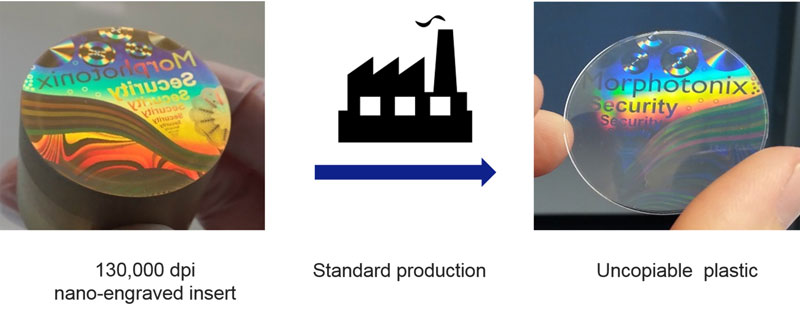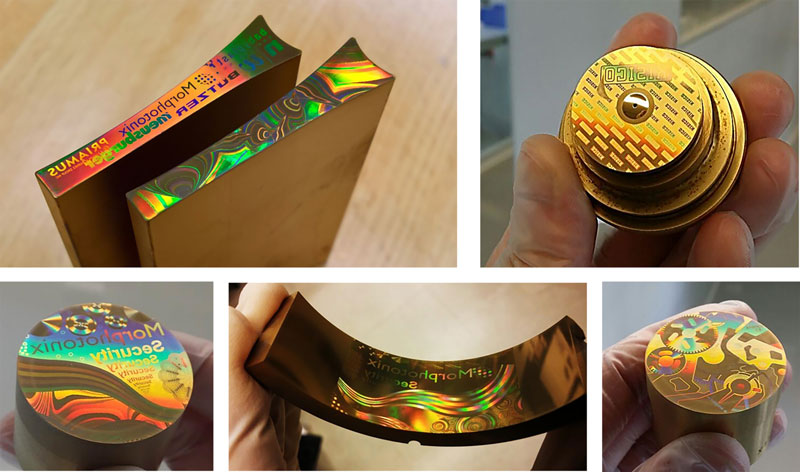by Veronica Savu, CEO, Morphotonix
From the thousands of males flapping around her, the blue morpho butterfly must choose her mate. How does she single out Mr. Right from among the contenders? Each morpho butterfly has wings with millions of tiny scales – shimmering nanostructures tuned to the wavelength of light. Lepidopterists believe the butterfly sees the unique pattern of her true love shining in the light.

What evolved in nature now has been captured by science and brought to product protection. Unbeknownst to her, the butterfly flies at the cutting edge of anti-counterfeiting technology. Like butterfly wings, nano-engraving produces ordered and periodic micro and nanostructures that effectively split light into its fundamental colors and wavelengths, controlling its reflection. When this is done in steel tooling, the resulting molded parts carry over the same optical effects.
Etched in hardened steel with a precision higher than 1/100 the width of a human hair (the cross section of a hair is 70 to 100 micrometers), wavelengths between 400 and 800 nanometers replicate the hues of visible light. A larger range has effects other than color: Beyond 20 micrometers, the light is no longer split, and as small as 200 nanometers – below which replication into plastic using molds leads to rapid erosion, difficult maintenance and tool cleaning problems.
When the engraving is molded on a polymeric product, the result is a customized image, an irreproducible hologram that proves authenticity at a glance. Prior technology – using a laser for interference lithography to produce basic visual effects – was only possible on flat steel surfaces with uniform diffraction from fixed periodicity, size and height. A much stronger security solution has been created – an image that curves within a product’s form, like the morpho’s pattern curves with its wing, with nano-optics across the full range of light.
For products as for butterflies, optics are only part of the story. Where the butterfly also adds pheromones and behavior to her quest for a mate, manufacturers need to consider the specific properties of the polymers and processes they use.
New research has improved understanding of how polymers behave during injection at micro and nano scales. The behavior deviates from that of the bulk material, and sometimes special conditions – in terms of temperature, pressure and hold times – have to be met for an optimum replication at this scale.
The conference PRN Polymer Replication at the Nanoscale, started in 2014, is an example of an efficient exchange platform for the latest scientific studies in this field, with industry and academic expert participation.
One can adjust the molding process for polymers to replicate the mold surface accurately. For example, hot-fill blow-molding (tool temperature as high as 160°C) with PET can achieve a finer structure replication than standard cold blow-molding (tool temperature as low as 12°C). But how much does one have to tweak the injection molding to replicate these nano features?
Heat/cool technologies are usually used to enhance the replication of the tool surface. But a hotter mold needs a longer cooling time, which slows the production rate. Slower production is fine for lower-volume products, such as auto parts (maybe 5,000 units a year), but is a no-go for high-volume products, such as soft beverage bottles (maybe five million units a day). Too high a temperature also can lead to inadequate structural changes for technical and medical parts, for which complex engineered plastics are essential, and the injection process should not be changed to suit imaging efficiency.
The technology platform leaves full control over the nanostructure’s size, which means that the tooling can be implemented in production without changing the standard injection process, while lasting millions of cycles.
It is with shape, though, that most people can truly see the innovations – complex 3D tools create a high visual impact at the same time they produce unbeatable security. Due to a proprietary processing step during molding of the steel, the nano-engraved tools can be cleaned and maintained with usual industrial steps.
The technology is backed by knowledge accumulated during decades of European research in the field of nano-imprint lithography (NIL) and micro/nano molding. A technology platform was developed with the clear goal of having it fit industrial needs and requirements. The processing of the molds is done in a state-of-the-art Swiss cleanroom. There, custom branding and security designs orginate with the same advanced lithography machines used to create passport security holograms and the most recent integrated circuits. Once client designs are originated, they are transferred using proprietary technology into bulk steel inserts or cavities, be they flat or free form.
Specialty chemical company Clariant worked early on to make products and packaging more successful in the marketplace. Its ColorForward trend analysis and color design tool is released annually to help plastic product designers and marketing professionals make more informed color choices. In “Palette Forward 2016,” the molded hologram was featured, capturing important societal trends affecting consumer behavior.

In 2018, Eastman Chemical Company and cosmetics house Group Rocher introduced an eco-design collaboration at LuxePack Monaco. Through collaborative innovation with partners, including Morphotonix, they created a compact case that illustrates a continuous journey to reduce their footprint. Engraved holographic morpho butterflies were molded directly from the tooling on the compact – illustrated with a video that surprises with its realistic rendering. The Amazonian inspiration was used to support customers with sustainable development and solutions.
In 2019, the In-Mold Decorating Association (IMDA) awarded the Best Technical Achievement: Holographic Closure Technologies to United Caps for a holographic in-mold label. To create this unique and secure bio-inspired and sustainable closure design, steel cavities were nano-engraved with 130,000 dpi precision custom diffractive holograms, which were replicated by United Caps into the closures via injection molding. The cavities were seamlessly integrated in the molding line, and the closures were produced at standard speeds, with zero additional consumables. The irremovable security designs provide immediate verification without scanning.
Protecting plastic products against counterfeits is most efficient when overt and covert security features are combined. Overt features can be verified with the naked eye and are usually difficult to copy, given their use of printed inks with special effects or labels such as ones containing holograms/tactile features (correlated with serial numbers or unique quick response [QR] codes). Covert features are verified by disclosing the information to inspectors, who use a controlled-access mobile phone application or other product-dedicated device. They include taggants (pigments), printing on plastic with security inks or image processing for authentication of natural product roughness.
Security taggants need to be mixed with the plastic through the products’ volume – an expensive process for larger parts. Using too low a taggant concentration involves complex read-out equipment, which can mean sending the product to specialized laboratories to be verified, preventing instant authentication in the field.

Printing on plastic is an expensive process for large-volume goods, comes with technical complexities for non-flat parts and includes the possibility the print will fade with time. One additional method is imaging the micro-roughness of each tooling cavity in a specific location with high-resolution image processing software.
The result then is correlated via a downloadable smartphone application with the surface image of the product molded from it. This is a cost-effective solution for large-volume production but also requires disclosing the specific location on the product containing the features.
Economizing on marking can lead to paying double on the follow-up infrastructure to be built, so multilevel (covert and overt) security features that are easy to detect in the field are an advantage. A solution seamlessly integrated in production, with no consumables or extra-energy processing also would support the brands’ sustainability goals. Tool nano-engraving offers all of the above, with the added bonus of a unique product look and a natural consumer engagement.
Millions of blue morpho butterflies flit through the Amazon, and now more than one hundred million product units – from nutraceuticals to medical devices to spirits to automotive and technical parts – are secured with inspiration from their wings. Retail customers appreciate the beauty of the designs, while manufacturers appreciate the security the designs add to their products. Authenticity, at the extremes of the nano wavelengths of light, has taken flight.

Veronica Savu is CEO and co-founder of Morphotonix. A brand protection executive, her focus is on anti-counterfeiting solutions. Savu and Morphotonix co-founders developed a patented, eco-friendly technological platform that provides uncopiable, multi-level security features embedded directly in polymeric products during standard manufacturing. Their solution is based on nano-engraving metallic articles/molds. For more information, visit www.morphotonix.com. For videos of Morphotonix’s nano-engraved security features molded on products, visit http://bit.ly/2KsDcbV.


